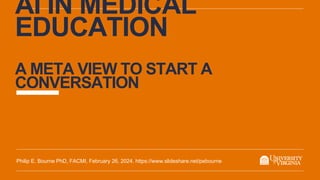AI in Medical Education A Meta View to Start a Conversation
- 1. AI IN MEDICAL EDUCATION A META VIEW TO START A CONVERSATION Philip E. Bourne PhD, FACMI, February 26, 2024. /pebourne
- 2. ŌĆō I have no formal medical school training ŌĆō I was the first Chief Data Officer of NIH ŌĆō I have taught many pharmacy students ŌĆō I tend to see everything through the lens of data ŌĆō AI is only part of the story ŌĆō I complained that medical school curricula were not in keeping with DISCLAIMER/BIA S
- 3. THE (NON-MEDICAL) STUDENTS HAVE SPOKEN ŌĆō Its here, itŌĆÖs a tool ŌĆō A tool like never before ŌĆō How to relate to the honor code ŌĆō DonŌĆÖt get caught up in the hype ŌĆō Wish professors knew more ŌĆō Want to know more about the implications Soon to be posted
- 4. HOW DID WE GET HERE? ŌĆō AI consumes data of all types: 90% of the worlds data was generated in the last 2 years ŌĆō Medical data is a mess ŌĆō Kudos to GW Bush ŌĆō Improved computer technology ŌĆō UVA was behind but is catching up ŌĆō Breakthroughs in algorithms and hence software providing persistent models ŌĆō This has got everyone's attention A zetabyte is 1012 gigabytes
- 5. CONSIDER OUR FAVORITE EXAMPLE - ŌĆō ChatGPT is one of many forms of AI ŌĆō A Large Language Model ŌĆō ŌĆØGŌĆØ generative ŌĆō ability to generate language, images, video, code ŌĆ” ŌĆō ŌĆ£PŌĆØ pre-trained ŌĆō unsupervised learning on vast amounts of content ŌĆō The training is done by neural networks that mimic the brain ŌĆō learning by adjusting weights of each ŌĆ£neuron/node). Training stops when the right result is achieved. That network is then a model that can produce {mostly} the right answer from data it has never seen before ŌĆō ŌĆØTŌĆØ Transformers allow for parallel computation and treats text etc. as tokens ChatGPT
- 6. ŌĆō Diagnostic and image analysis ŌĆō Predictive analytics ŌĆō Personalized medicine ŌĆō Drug discovery ŌĆō Robot assisted surgery ŌĆō Virtual health assistants ŌĆō Clinical trials research ŌĆō Wearables ŌĆō Healthcare operations ŌĆō Mental health applications THE NOW - EXAMPLES
- 7. WHERE ARE WE HEADED? The current deep neural networks are equivalent to a rice grained size of the cerebral cortex and we are yet to explore most aspects of brain morphology Terry Sejnowski https://www.pnas.org/doi/full/10.1073/pnas.1907373117
- 8. What Does This Mean in Practical Terms with AI
- 9. ŌĆō AR changes the student- student; student-patient dynamic ŌĆō LLMs provide a rich training ground ŌĆō Student-mentor relationships will be different, but remain important. PEDAGOGY Images by DALL-E
- 10. RESEARCH A Biomedical Researcher The Holy Grail of Molecular Biology Food production Energy production Drugs ŌĆ” ŌĆō Achieved by DeepMind (a Google spin off) not academia ŌĆō 30 interdisciplinary scientists working together not competing ŌĆō Compute power beyond a university
- 11. THREATS OPPORTUNITIES Creating a new health care industry
- 12. How Disruptive Will It Be?
- 13. THE 6 DŌĆÖS (PETER DIAMANDIS) Digitization Disruption Demonetization Dematerialization Democratization Time Volume, Velocity, Variety Digital media becomes bona fide form of communication Deception
- 14. KODAK ŌĆō A 6DŌĆÖS CASE STUDY Digital media becomes bona fide form of communication
- 15. WILL HISTORY REPEATS ITSELF? MEDICINE Digitization Deception Disruption Demonetization Dematerialization Democratization Time Volume, Velocity, Variety AI impact minimal Models reach human capacity Augmented reality, sensors Quantum computing Digital media becomes bona fide form of communication Learning modalities change Knowledge workers must adapt job market shifts Robotics Research practice changes
- 16. THANK YOU Philip E. Bourne February 21, 2024, Leadership Meeeting
- 17. TWO DIFFERENT FUTURES ACCORDING TO DALL-E
Editor's Notes
- Demis Hassabis and John Jumper winners of 2023 Lasker Award Basic Biomedical Research

















